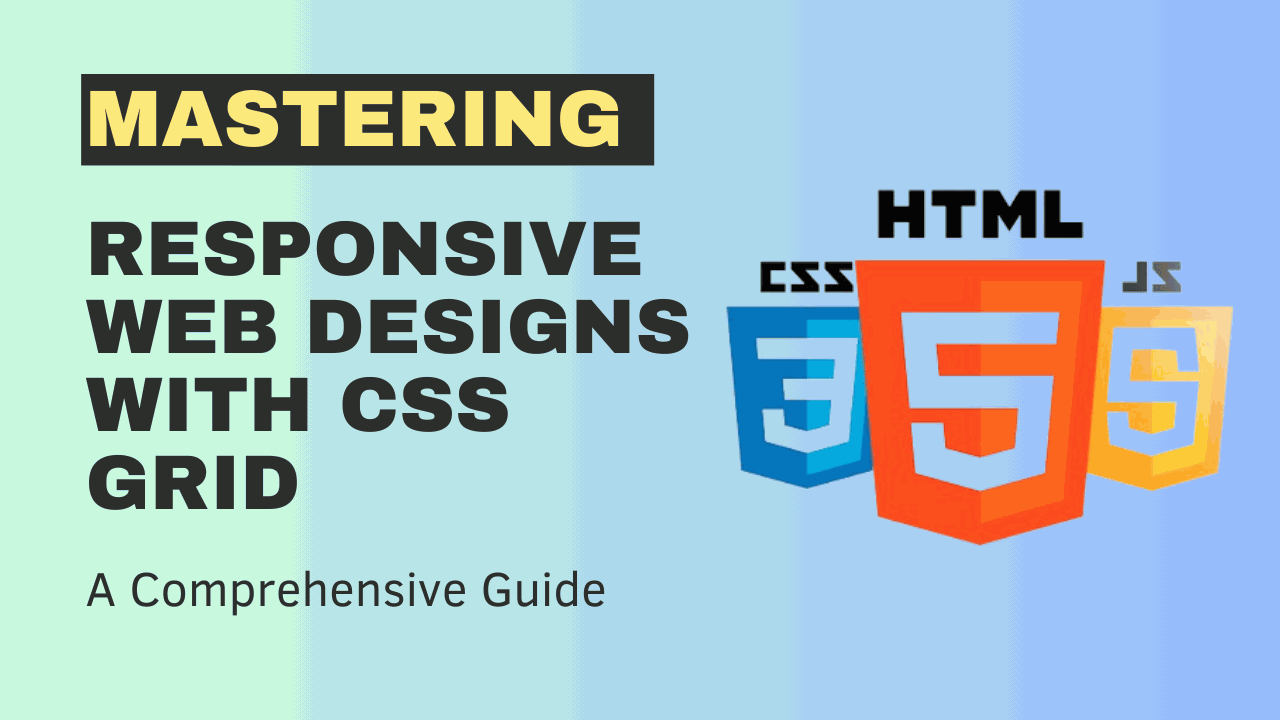In today's digital age, ensuring your website looks great and functions seamlessly across various devices is paramount. With the proliferation of smartphones, tablets, and desktops, mastering responsive web design techniques has become essential.
One powerful tool at your disposal is CSS Grid, which allows you to create dynamic, responsive layouts with ease. In this comprehensive guide, we'll delve into the world of CSS Grid and how it can elevate your web development skills to create stunningly responsive designs.
1. Introduction: Embracing Responsive Design
Understanding the Importance of Responsive Design
Responsive design is the approach of crafting websites to provide an optimal viewing and interaction experience across a wide range of devices. Whether it's a smartphone, tablet, laptop, or desktop, users expect websites to adapt seamlessly to their screen size and orientation.
The Evolution of CSS Grid in Web Development
CSS Grid has emerged as a game-changer in web development, offering a robust layout system that enables developers to create complex grid-based designs with simplicity and flexibility. Unlike traditional methods such as floats or positioning, CSS Grid provides a more intuitive approach to building responsive layouts.
2. Getting Started with CSS Grid
What is CSS Grid?
CSS Grid is a two-dimensional layout system that allows you to create grid-based designs for arranging elements on a webpage. It provides precise control over the placement and alignment of content, making it ideal for building responsive layouts.
Key Concepts and Terminology
- Grid Container: The parent element that contains grid items.
- Grid Items: The children of the grid container that are placed within the grid.
- Grid Lines: The horizontal and vertical lines that define the grid's structure.
- Grid Tracks: The rows and columns that make up the grid.
- Grid Areas: Rectangular areas of the grid that contain one or more grid items.
Browser Support and Compatibility
CSS Grid enjoys widespread support across modern web browsers, including Chrome, Firefox, Safari, and Edge. With most users accessing the web through updated browsers, you can confidently leverage CSS Grid in your projects without worrying about compatibility issues.
3. Fundamentals of Responsive Design
Principles of Responsive Web Design
- Fluid Grids: Designing layouts with proportional units rather than fixed pixels.
- Flexible Images: Using relative units to ensure images scale proportionally.
- Media Queries: Applying CSS rules based on the device's characteristics, such as screen width and orientation.
Challenges and Solutions in Responsive Layouts
- Content Reordering: Adjusting the order of elements to accommodate different screen sizes.
- Viewport Meta Tag: Setting the viewport width to control the layout on mobile devices.
- Touch-Friendly Navigation: Implementing larger tap targets and swipe gestures for touchscreens.
Importance of Mobile-First Approach
Adopting a mobile-first approach involves designing for the smallest screen size first, then progressively enhancing the layout for larger screens. This ensures a seamless user experience across all devices and prioritizes performance and accessibility.
4. Building Responsive Layouts with CSS Grid
Setting Up the Grid Container
To create a grid layout, designate an element as the grid container using the display: grid; property in CSS.
.container {
display: grid;
}Defining Grid Tracks and Gutters
Specify the size of grid rows and columns using the grid-template-rows and grid-template-columns properties. You can also adjust the spacing between grid cells with the grid-gap property.
.container {
grid-template-rows: 100px 200px;
grid-template-columns: 1fr 2fr;
grid-gap: 20px;
}Placing Items on the Grid
Position grid items within the grid using the grid-row and grid-column properties. You can also use named grid areas for more clarity in your layout.
.item {
grid-row: 1 / 2;
grid-column: 1 / 3;
}Utilizing Responsive Units: fr, minmax, auto
- fr: Represents a fraction of the available space in the grid container.
- minmax: Specifies a size range for grid tracks, allowing them to flexibly adapt to different screen sizes.
- auto: Automatically sizes grid tracks based on their content.
Creating Flexible and Fluid Grids
By combining relative units like percentages and viewport widths with CSS Grid, you can create layouts that scale fluidly across various devices. This ensures your design remains visually appealing and functional regardless of screen size.
5. Advanced Techniques for Responsive Web Design
Media Queries and Breakpoints
Media queries allow you to apply specific CSS styles based on the device's characteristics, such as screen width, height, and orientation. By defining breakpoints at key screen sizes, you can tailor the layout to different devices.
Grid Layouts for Different Screen Sizes
Consider designing multiple grid layouts optimized for different screen sizes, such as mobile, tablet, and desktop. This approach ensures a tailored experience for users on each device, maximizing usability and engagement.
Creating Complex Grid Structures
CSS Grid's powerful features, such as grid template areas and grid spanning, enable you to create intricate layouts with ease. Experiment with nested grids and overlapping grid items to achieve sophisticated designs.
Handling Content Reordering
Use CSS Grid's order property to control the visual order of grid items, allowing you to rearrange content dynamically based on screen size or user preferences. This flexibility enhances the user experience by prioritizing important content on smaller screens.
6. Best Practices and Optimization
Semantic HTML Structure for Accessibility
Ensure your HTML markup follows best practices for accessibility by using semantic elements like <header>, <main>, <nav>, and <footer>. This improves screen reader compatibility and enhances the overall usability of your website.
Performance Considerations
Optimize your CSS Grid layouts for performance by minimizing unnecessary grid tracks and using efficient CSS properties. Avoid excessive nesting and use CSS grid debugging tools to identify and address layout issues.
Testing and Debugging Techniques
Thoroughly test your responsive layouts across various devices and screen sizes using browser developer tools and online emulators. Debug any layout inconsistencies or responsiveness issues to deliver a seamless user experience.
7. Case Studies and Examples
Showcase of Responsive Websites Built with CSS Grid
- Example 1: E-commerce website with a fluid grid layout for product listings and responsive navigation menus.
- Example 2: Portfolio website featuring a dynamic grid gallery that adjusts seamlessly to different screen sizes.
Analysing Successful Implementations
Study real-world examples of websites that effectively utilize CSS Grid for responsive design. Analyze their layout structure, breakpoints, and content reordering strategies to gain insights for your own projects.
8. Future Trends and Considerations
Emerging Technologies in Web Development
Stay abreast of new developments in web technologies, such as CSS Grid Level 2 and CSS Grid Frameworks. These advancements promise even more powerful tools and capabilities for building responsive web designs.
Continuous Evolution of CSS Grid and Responsive Design
As the web landscape evolves, so too will CSS Grid and responsive design practices. Embrace a growth mindset and continually refine your skills to adapt to changing trends and user expectations.
Adapting to Changing User Expectations
User preferences and behaviours are constantly evolving, driving the need for innovative approaches to responsive design. Stay attuned to user feedback and analytics data to iteratively improve your website's responsiveness and usability
9. Real-World Example: E-commerce Website
Consider an e-commerce website that needs to display products in a grid layout. With CSS Grid, you can easily create a responsive grid that adjusts the number of columns based on the screen size. This ensures that the product grid looks great on both desktop and mobile devices, providing an optimal shopping experience for users.
10. Comparison: CSS Grid vs. Other Layout Methods
| Feature | CSS Grid | Flexbox | Floats |
|---|---|---|---|
| Layout Complexity | Low | Medium | High |
| Responsiveness | High | Medium | Low |
| Browser Support | Modern browsers | Modern browsers | All major browsers |
| Grid Control | Precise | Limited | Limited |
| Alignment | Built-in alignment controls | Requires additional rules | Requires additional rules |
FAQs
Is CSS Grid supported in all browsers?
CSS Grid is supported in all modern browsers, including Chrome, Firefox, Safari, and Edge. For older browsers, you may need to provide fullbacks or use polyfills to ensure compatibility.
Can I use CSS Grid alongside other layout methods like Flexbox?
Yes, CSS Grid can be used in conjunction with other layout methods like Flexbox to create more complex and dynamic layouts.
How does CSS Grid compare to frameworks like Bootstrap?
While frameworks like Bootstrap provide pre-built components and layouts, CSS Grid offers more flexibility and control over the layout, allowing for more customized and responsive designs.
Conclusion
Mastering CSS Grid empowers you to create responsive web designs that seamlessly adapt to various screen sizes, providing an optimal user experience across devices. By understanding the principles of responsive design, harnessing the capabilities of CSS Grid, and employing best practices, you can elevate your web development skills and deliver exceptional digital experiences.
Have you experimented with CSS Grid in your web projects? Share your thoughts and experiences in the comments below!
Remember, your comments and insights are always valuable. Share your thoughts below and let's continue the conversation!



Write a comment